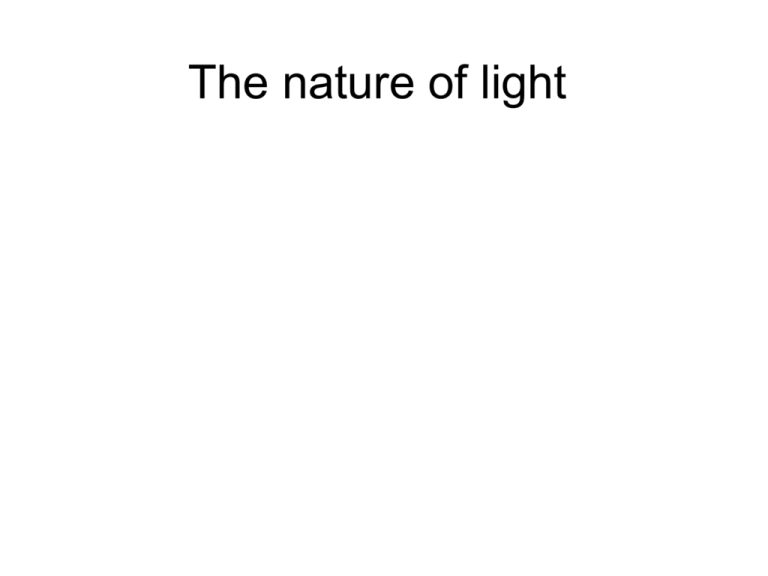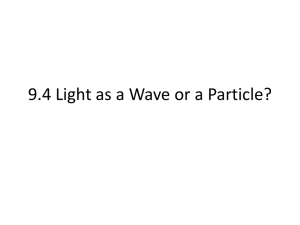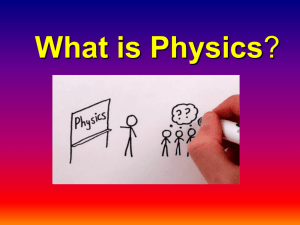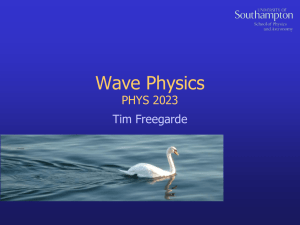The nature of light - FIU Faculty Websites
advertisement

The nature of light Newton’s Corpuscular Theory (1670) According to Isaac Newton ( 1642 - 1727 ) in his "Opticks" ( 1704 ) light is composed by particles which are transmitted at a finite speed by the "Luminiferous Aether Wind" , a common or universal medium of propagation. The Luminiferous Aether was imagined by physicists since Isaac Newton as the invisible "vapor" or "gas aether" filling the universe and hence as the carrier of heat to our body and light to our eyes. Light and aether How fast does the light propagate? The speed of light in a vacuum is defined to be exactly 299,792,458 m/sec, (approximately 186,282 miles per second). Different physicists, including Galileo, have attempted to measure the speed of light throughout history. We will discuss in detail the experiment of Michelson and Morley (1887) • The following phenomena are commonly observable: • Reflection • Rifraction • Diffraction Reflection: Newton’s theory explained the phenomenon of reflection by assuming that the light particles bounce on the mirror) • Example: a ray of light hits the surface of a mirror at an angle of 30^0 with the surface. What is the angle that the light forms with the mirror when it bounces back? • Example: a ray of light hits the surface of a mirror at an angle of 30^0 with the surface. What is the angle that the light forms with the mirror when it bounces back? • Answ: 30^0 Reflection of light occurs when the light encounter a surface or other boundary that does not absorb energy, and allows the light to bounce away from the surface. The simplest example of visible light reflection is the surface of a smooth pool of water, where incident light is reflected in an orderly manner to produce a clear image of the scenery surrounding the pool. Throw a rock into the pool and the water is perturbed to form waves, which disrupt the reflection by scattering the reflected light rays in all directions. The light goes from the sun, to the lake, to your eye, and you perceive the images as coming from the lake. Refraction. • It is the "bending" of light at the interface of two materials of different density. It accounts for the focusing action of lenses. Atmospheric refraction (due to the curve of the Earth's surface and the variation of atmospheric density with height, in turn dependent on meteorological conditions) is the effect which makes the Sun (or other celestial body) look slightly higher in the sky than its true astronomical position. • The Refractive index (µ, MU): of a medium (or its index of refraction) is defined as the ratio of the speed of light in a vacuum to its speed in the medium. Refraction The corpuscular theory also explained the phenomenon of refraction (the light particles change their direction when they enter a medium of different density) The denser is the medium, the more the light bends The refraction of light is also responsible for the optical phenomenon of mirage. There is no water in the sand; what the image captured is the reflection of the sky! The man sees the palms reflected in the sand … • But this is an illusion. Cold air is denser than warm air and has therefore a greater refractive index. As light passes from colder air across a sharp boundary to significantly warmer air, the light rays bend away from the direction of the temperature increase. When light rays pass from hotter to colder, they bend toward the direction of the temperature increase. If the air near the ground is warmer than that higher up, the light ray bends in a concave, upward trajectory. • Once the ray reaches the viewer’s eye, our brain interprets it as if it traces back along a perfectly straight "line of sight". In the previous image, an "inferior image" of the sky above appears on the ground. The viewer may incorrectly interpret this sight as water which is reflecting the sky, which is, to the brain, a more reasonable and common occurrence. Diffraction of light • Newton found out that the white light from the Sun is composed of light of different color, or spectrum (1670). Each color cannot be further decomposed. If you put a screen in front of the light decomposed by the prism that lets only one color through …. Each color cannot be further decomposed. If you put a screen in front of the light decomposed by the prism that lets only one color through …. • This experiment was performed by Newton. • Before him, it was believed that white light was colorless, and that the prism itself produced the color. Newton's experiments demonstrated that all the colors already existed in the light and that "corpuscles" of light were fanned out because particles with different colors traveled with different speeds through the prism. A rainbow is a phenomenon that causes a spectrum of light to appear in the sky when the Sun shines on to droplets of moisture (that act like prisms) in the Earth’s atmosphere. • • These phenomena can also be explained with Fermat's principle or the principle of least time • It is s the principle that the path taken between two points by a ray of light is the path that can be traversed in the least time. This principle is sometimes taken as the definition of a ray of light • Pierre de Fermat ( 1601 or 1607 – 12 1665) was a French lawyer at the Parlement of Toulouse, France, and … an amateur mathematician. • He made notable contributions to analytic geometry, probability, and optics. • He is best known for Fermat's Last Theorem, • The “theorem” says: there is no integer numbers x, y and z for which satisfy the “generalized Pythagoras theorem” x^n+y^n=z^n when n=3 or larger. • This property was proved only in 1995 by A. Wiles, a professor at Princeton Univ; the proof made international headlines and Wiles won a million dollars prize for it. The diffraction of light was hard to explain under the assumption that the light is composed by particles. It can be explained by assuming that the white light is composed by the superposition of seven different waves each with its own frequency, that we perceive as colored lights Back to the Fermat’s principle: • Explaining the reflection with Fermat’s principle is easy. • Explaining the diffraction is easy too (light particles of different colors travel with different speed through the prism, and they separate because they chose the path of least resistance) • Explaining the diffraction is not so bad either: the light travels and different speed in different materials, and it bends because it chooses the path of least resistance between the two materials • If a life guard on the beach has to run to rescue a person drowning at sea, he won’t go on a straight line toward the drowning person: he’ll run on the beach for the longer stretch and swim for the shorter stretch because he can run faster than he can swim. • But Newton’t theory could not explain why a light ray that passes though a pinhole spreads out in circular patterns … Newton and Hooke • R. Hooke suggested a wave theory of light in his Micrographia (1665), comparing the spreading of light vibrations to that of waves in water. He suggested in 1672 that the vibrations in light might be perpendicular to the direction of propagation. • Newton rejected a simple wave theory of light because it could not account for rectilinear propagation. It never occurred to him that the waves of light might be very, very small. Newton and Huygens • In 1678, Dutch physicist, Christiaan Huygens, believed that light was made up of waves vibrating up and down perpendicular to the direction of the light travels. This became known as 'Huygens' Principle'. Huygen, suggested that light wave peaks form surfaces like the layers of an onion. In a vacuum, or other uniform mediums, the light waves are spherical, and these wave surfaces advance or spread out as they travel at the speed of light. • This theory explains why light shining through a pin hole or slit will spread out rather than going in a straight line. Newton's theory came first, but the theory of Huygens better describes the motion of light. Huygens' principle lets you predict where a given wavefront will be in the future, if you have the knowledge of where the given wavefront is in the present. • Young’s Double-Slit Experiment definitely confirmed that the light behaved as a wave (1801). The light passes through two closely spaced slits …and that’s what you see… This is an actual picture of light’s interference. Light has wavelike property • Young’s Double-Slit Experiment definitely confirmed that the light behaved as a wave (1801). The light passes through two closely spaced slits…. • The alternating black and bright bands appearing on the screen is analogous to the water waves that pass through a barrier with two openings Interference of waves • This phenomenon is called interference; Viewing the light as a wave allows to explain also the phenomena of reflection… … and refraction. In the denser medium the wave propagates at a lower speed. …But it could not explain the photoelectric effect • In the photoelectric effect, electrons are emitted from metals, liquid or gasses, as a consequence of their absorption of energy from electromagnetic radiations of very short wavelength, such as … visible light. Heinrich Hertz showed in 1887 that electrodes illuminated with ultraviolet light create electric sparks more easily. Photoelectric effect • Light Electrons Dual properties of Light: (1) waves and (2) particles • Light is an electromagnetic radiation wave, e.g, Young’s double slit experiment • Light is also a particle-like packet of energy - photon – Light particle is called photon – The energy of phone is related to the wavelength of light • Light has a dual personality; it behaves as a stream of particle like photons, but each photon has wavelike properties • The photons have not been measured and isolate in laboratory yet.







